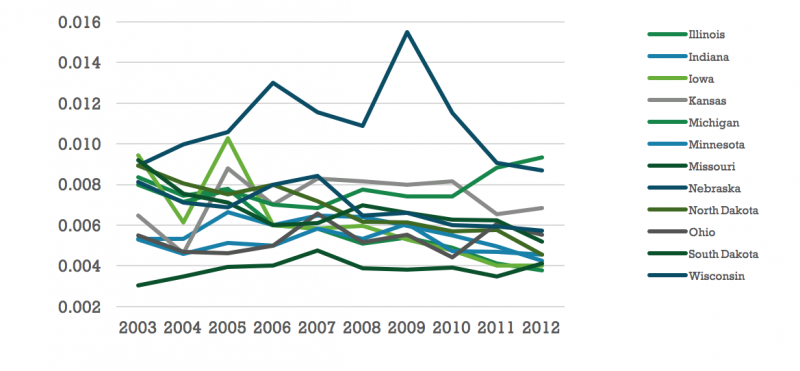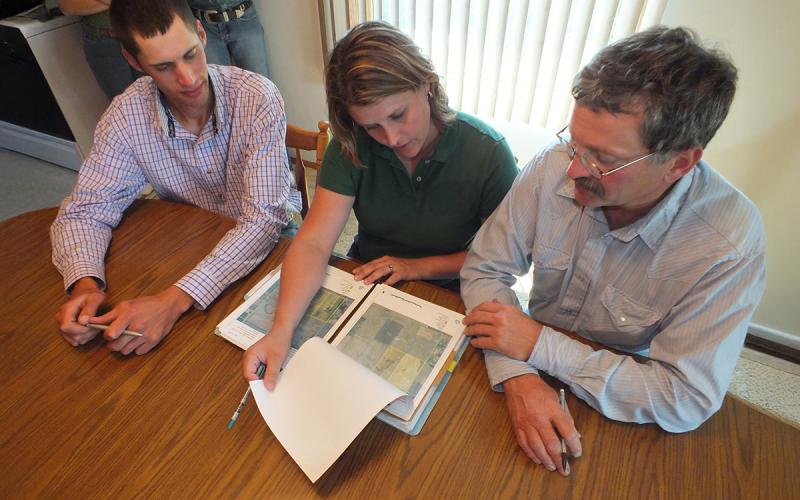About the Survey
Conducted since the mid-1990s, the USDA Agricultural Management Resource Survey (ARMS) is a multi-phase, multi-level nationwide survey of agricultural producers that collects information on a large sample of farms and their characteristics. Data collected includes financial performance, expenses, revenues, farm organization characteristics, farm management techniques, use of contracts, and operator demographic characteristics (USDA ERS). Each year, approximately 30,000 producers are randomly targeted to respond to the survey using a list or area frame, and a subset of producers provide commodity-specific (e.g. corn producers) information about their farm management practices and use of resources at the field level (Phase II). Data is collected from the full sample across all commodities on farm financials, household income, and farm and household characteristics (Phase III). The Economic Research Service (ERS) includes additional data in the dataset related to the environment in which the farms operate, including prevailing wage rates, the population, and the county’s economic dependence on farming.
Research & Outreach Uses
The ARMS survey has been a useful resource for ongoing research related to farm performance and risk, farm organizational changes, sustainability of farm production by region, comparing alternative state policy impacts on farm performance, and measuring the economic impact of farm production. Previous and ongoing research has and will continue to be integrated into extension outreach materials and programming to be distributed to Ag producers to enhance their competitiveness and financial performance. Furthermore, the findings are used to inform policymakers who explore alternative Ag policy. At South Dakota State University, the USDA-ARMS survey is used in ongoing research to study farm financial performance and risk, sustainability, and state property tax policy.
Financial Performance Analysis
Currently, The SDSU Department of Economics is measuring long-term financial performance and risk of regional producers by area and commodity specialization. The financial measures examined include return to capital, return to labor and management, and resource efficiency. This analysis assesses areas and characteristics that are superior or inferior in average returns when considering risk of returns overtime. The findings gained will be integrated into SDSU Extension publications and workshops that will inform on best management practices and methods to improve farm performance while reducing risk. Possible changes to improve financial performance include changes to organization, adoption of alternative practices, investment in infrastructure, improving access to markets, reducing or increasing variety of production, etc. For example, Key, McBride, and Mosheim (2008) have used ARMS data to study factor productivity and contracting in the hog sector. They have found significant gains in productivity for hog farms that use production contracts and have increased scale. The intended outcome of farm financial performance studies is to improve the socioeconomic status of all farm producers in the U.S. by identifying management and organization changes that can enhance their financial performance.
Sustainability Studies
ARMS data is also used to analyze resources used in the production of agricultural commodities to promote sustainability. Sustainable production is typically defined as production that improves resource efficiency and reduces environmental impacts. The findings from sustainability research helps assess sustainability benchmarks for agriculture production such as average farm greenhouse gas emissions, fertilizer efficiency, fuel use, etc. The sustainability metrics are needed to monitor and promote the continuous improvement in resource use that has been observed in U.S. agriculture over the last thirty years (Field to Market 2016). Moreover, researchers use the findings of resource sustainability research to demonstrate historical continuous improvement and project future improvement to external stakeholders and consumers. For example, Shapouri, Dufield, and Wang (2003) used the ARMS data in a study that estimated the net energy value from ethanol obtained from corn. They showed that corn ethanol had improved from previous studies to a net energy gain between 1.34 and 1.53. The findings on resource use from USDA-ARMS enhances U.S. agricultures ability to promote its products and communicate a message of an increasing production of food, fuel, and fiber while reducing negative environmental impacts.
Federal & State Policy Assessment
A third area ARMS data is used in is research on alternative federal and state policies that impact farm performance. We are currently comparing alternative property tax policies to assess agricultural land for property tax purposes. Some states use a market value approach, while other states use a formula based, use-value approach. The method of calculating Ag land assessments, and local and state government expenditures and revenue sources, can have a significant impact on the property tax liability of farms. Using the ARMS data, the SDSU Department of Economics compares the annual effective property tax rates (ratio of property taxes paid to the reported market value of land and buildings) by state and assessment policy (see Figure 1). It also continues to monitor farm property tax liability, policies, and impacts on farm producers’ net income in order to report changes to Ag producers and policymakers.

In Summary
Without the USDA-ARMS data, research in these areas would likely be more costly and of lower quality. The large, centralized ARMS dataset that is comprehensive, long-term, and collected using similar measurements and consistent processing and collection methods overtime has given U.S. Agriculture researchers a competitive advantage compared to Ag researchers in foreign countries. The findings from studies using ARMS data improves our overall understanding of long-term U.S. agriculture performance, resource utilization, and economic impacts to the agricultural sector. Furthermore, the data enhances the ability to monitor and quantify impacts to U.S. farm performance because of infrastructure investment, policy changes, market volatility, and changes in climate. These studies are then reported to policy makers and Ag stakeholders.
Increasing use of the ARMS data for outreach materials depends on the quality and quantity of the data being provided by respondents. If response rates decline, or if the quality of data being provided is reduced, then the ability to accurately assess changes and impacts becomes increasingly difficult, particularly for more localized decision-making. For these reasons, the South Dakota State University Department of Economics encourages agriculture producers who have been targeted for an ARMS survey to take the time and make the best effort to respond to the ARMS survey questions as accurately as possible. The quality of research and information that can be returned to producers and policy makers depends on the quality and rate of producer responses.
References:
- Shapouri, Hosein, J. A. Duffield, and M. Wang. "The energy balance of corn ethanol revisited." TRANSACTIONS-AMERICAN SOCIETY OF AGRICULTURAL ENGINEERS 46.4 (2003): 959-968.
- Key, Nigel, William McBride, and Roberto Mosheim. "Decomposition of total factor productivity change in the US hog industry." Journal of Agricultural and Applied Economics 40.01 (2008): 137-149.
- Field to Market: The Alliance for Sustainable Agriculture, 2016. Environmental and Socioeconomic Indicators for Measuring Outcomes of On Farm Agricultural Production in the United States (Third Edition). ISBN: 978-0-692-81902-9

